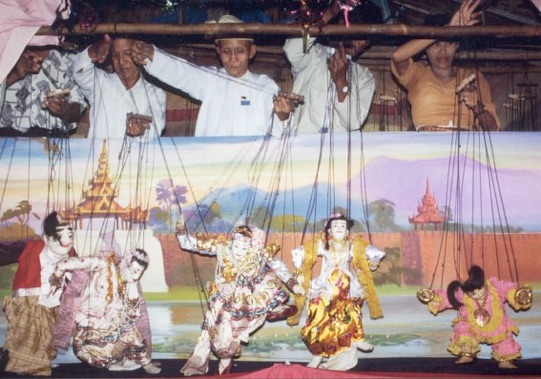Introduction

Traditional Burmese puppet theatre dates from the fifteenth century. It was fast disappearing, but lately performances have been given for tourists, which led to a revival of the interest among the Burmese people as well.

This scene shows the Prince and the Princess, accompanied by their lady-in-waiting and their clowns. Most puppets have eleven strings. Five of these strings attach the head, the shoulders and the rump to the H-shaped wooden cross piece. The upper arms, thighs and hands are operated with the six remaining strings which hang loose and are draped over the cross piece. Each puppet has its own particular way of dancing, with accompanying music and song. It is said that live dancers have copied their movements from the puppets.

A company consists of puppeteers, singers and musicians. Two singers sit next to the puppet players and sing or declaim the texts of the more complicated characters. The group travels around the country, with their puppets and stage equipment. There are pieces of scenery on the stage, such as a throne. Painted backdrops represent the scene of the action: a forest or a palace.
The photograph used for the cover and the Introduction of this presentation was taken in Thaketa, Yangon (Rangoon). It shows the puppeteers of U Tun Kyi's troupe performing the famous duet of the Prince and the Princess, accompanied by their Page, Lady-in-Waiting, and Clown.
This presentation has five 'chapters'. The first one deals with the play, the second one with the puppets and the characters they portray, the third chapter shows how a puppet is made, the fourth one deals with the music, and chapter five shows the relationship of the puppets and the human ritual world (nat pwe).
Welcome to the world of Thabin
Burmese puppetry, music, song and dance
A multimedia presentation by Elisabeth den Otter © 2021 (originally published as a CD-Rom in 2000)